| 1 |
 |
Page 1
“...Published by the Chefoo Schools Association
ASSOCIATION
The Chefoo Magazine
Centennial Issue
FEATURED IN ISSUE THIS
Many Faces of the 3
Chefoo Magazine
The First Decade 7
Between the Wars 13
During World War II 20
Post WWII China Years 27
Post China Schools & 33
Hostels
Chefusians Return to 40
China
In Memoriam - The
Headmasters 45
The year 2008 marks the 100th birthday of the Chefoo Schools Association!! This is a remarkable achievement, and we are still going strong, with active branches in Australia, New Zealand, North America, and the United Kingdom, and members residing within these jurisdictions, and many other places throughout the world.
To commemorate our 100 years, this entire special issue draws from items featured in The Chefoo Magazine since its inception in 1908. Read, and enjoy!...”
|
|
| 2 |
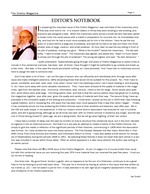 |
Page 2
“...endearing the Chefoo Schools were to their students and teachers, year after year. We in the CSA are quite unique, in my experience, in that our mission school alumni association has endured for over a hundred years, and still is going strong, although as we all know very well, with no Chefoo schools in existence any longer, and the last one in China having closed 57 years ago, we are a dying breed. But we will go down fighting, of that I am certain.
I have had a number of ideas over the past six months on how to structure this centennial issue, but in the end I decided to organize it into an historical account. Not that it is in any way an attempt to create a history of the Chefoo Schools, but simply to give the reader a reflection of the significant periods of their histories, commencing in 1908 when the Association was formed. So I have divided the issue into these sections: The First Decade; Between the War Years; World War II; Post WWII China; Post China Schools and Hostels; and Chefusians...”
|
|
| 3 |
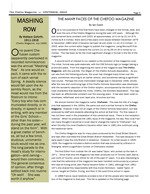 |
Page 3
“...by 28 cm (8 % inches by 11 inches). This has been by far the most significant change in format in the life of the magazine.
A second point of interest to our readers is the evolution of the magazine cover. The initial format was quite elaborate, with the CIM Schools logo (or badge) taking a prominent place. From the beginning the name of the magazine was The Chefoo Magazine, with the sub-title: The Organ of The Chefoo Schools Association. As you can see from the following pictures, the cover has changed many times over the years, sometimes returning to an earlier version, and sometimes taking a significant new course. Perhaps the most memorable change was in December 1935, shortly after the new and continuing logo of the Chefoo Schools Association was developed, with the wonderful depiction of the Chefoo dolphin, accompanied by the block of Chinese characters that depicted the motto, Chefoo, Old Scholars Association. This logo has been an affectionate constant over the ensuing years. It has...”
|
|
| 4 |
 |
Page 4
“...The Chefoo Magazine
CENTENNIAL ISSUE
Page 4
EDITORS OF THE CHEFOO MAGAZINE
Years as Editor Names Years at Chefoo Schools
1908-1917 Horace W. Hunt 1896-1900
1918-1921 Gertie (McCarthy) Chalice 1888-1892
1921-1923 Amy Gladys Willett 1902-1910
1923-1942 Howard F. Joyce 1909-1915
1943-1947 John G. Weller 1922-1930
1947-1953 John S. Hirst 1928-1934
1953-1961 Doris E. Rouse 1921-1932
1961-1962 Jean Pearce 1947-1951
1962-1971 Jean Pearce &
Eva (Cook) Nicholson 1927-1937
1971-1984 Isabel Taylor 1911-1922; Staff 1934-1966
1984-1991 Francis Rob Joyce 1946-1951
1991-2002 Dorothy (Cox) Chadborn 1948-1951
2003- Ian Grant 1946-1950
THE ORGAN OF
THE CHEFOO SCHOOLS ASSOCIATION....”
|
|
| 5 |
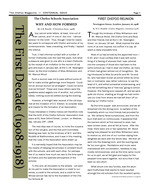 |
Page 7
“...Those interested in Chefoo history will therefore note that the birth of the Chefoo Schools’ Association took place at 91 New Oxford Street, London, on Wednesday, January 29th, 1908.
The next step was of course, to invite the cooperation of the old girls, and the first joint Committee Meeting was held, by the kindness of W.D. and Mrs. Mudditt at Walthomstow, and it was in this meeting that the rules of the Association were drawn up. . .
It is earnestly hoped that the Association may be the means of keeping old scholars in constant touch with the schools, and with each other, for perhaps few of us realize how much we owe to the time spent at Chefoo and the splendid atmosphere of the schools.
To this end, all shoulders to the wheels. Let each do his part to make the Association a credit to ourselves, a credit to the schools, and a credit to Him, Whose service has led to the foundation of the Chefoo Schools.♦
FIRST CHEFOO REUNION
Newington Green, London, January 16,1908
By W.D. Mudditt (Chefoo...”
|
|
| 6 |
 |
Page 8
“...came into fashion in the Western world and the demand for hair nets dropped like a stone. Thousands of girls in the Chefoo factories lost their jobs and Chefoo never regained its’ preeminence.
Today very little human hair is used. Finer nylon thread is produced in larger quantities in Germany. It is then sent to Taiwan and various parts of China to be made into nets, taking advantage of cheap labour and it is re-exported to the West.4
(Continued from page 7)
al training received at the C.I.M. Schools, and it is only right that the masters and mistresses should know this, in order that they might be encouraged to go on in this branch of their work.
As a result of the reunion the C.S.A. was formed, and the Magazine, in which this article appears, shows that we all hope it will be a permanent institution; and there is no reason why it should not, if only the scholars, past, present and future, will do all they can to make it a gigantic success. W.D. Mudditt ♦
THE BAflflE
Chefoo Magazine, October...”
|
|
| 7 |
 |
Page 13
“...reached Chefoo on the morning of November 12th. Mr. McCarthy formally announced it from the rostrum. Afterwards the three schools and all the foreigners on the compound gathered round the flagstaff and sang the Doxology. Mr. Coulthard and Mr. McCarthy led in thanksgiving to God for the wonderful news that had been received, Mr. McCarthy especially returning thanks for the courage and patriotism of those who had laid down their lives in the terrible strife, and remembering those who had been bereft.
In the evening there was a big procession from the Settlement to the recreation ground, and here there was a big bonfire, and heaps of fireworks kept things lively. At last everyone gathered round the bonfire and sang the Doxology, all the National Anthems anyone knew, and cheered the Allies, representatives of all of whom were present.
The entire Boys’ and Girl’ Schools were there, and some of the “Prepites.” It was an occasion that will long live in the memory of all who took part.4
CHEFUSIANORUM...”
|
|
| 8 |
 |
Page 16
“...ANDREW
TWO OF THE OLD BOYS WHO
LAID DOWN THEIR LIVES IN
THE GREAT WAR
The families of the two Old Boys erected
the gates in their memory.
THE DEDICATION OF THE NEW GATES
(Chefoo Magazine, December 1929)
These gates, which now command the entry from the Beach Road to the B.S. field, were erected during the latter half of the last term. The Dedication Service, conducted by Mr. Coulthard, was held on the 22nd of August, and was attended by a large number, including all the scholars staying at the schools.
The meeting commenced with the singing of a hymn, “0 God, our help in ages past,” after which Mr. Coulthard read the 145th Psalm. Then Mr. McCarthy read the letter from the donors and made his speech, as given below:
“The beautiful gates, which have been given to the Boys’ School, like all its other property, belong to the China Inland Mission, and a record of the gift with a plan of the gates is in the Headquarters of the Mission in Shanghai. But the care of these gates will devolve on the...”
|
|
| 9 |
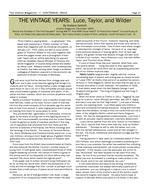 |
Page 17
“...Wallace Goforth, their contemporary at Chefoo, has been among other things a professor colleague of Stephen Leacock’s in the economic department of McGill University in Montreal.
Good wine must first be derived from vintage year and zone; but it also must have the ageing that brings it to maturity and full flavor. Among Chefoo’s best vintage years were those of 1911-15, for in this immediate pre-war period was concentrated a galaxy of character and talent, of students and their masters, which few schools anywhere could equal or surpass.
Barely a hundred “boarders”, plus a handful of lads from local families, made up the boys’ School roster of that day. Yet from this small company of four decades ago the world was to hear from several in quite ringing terms and it will go on hearing from them for some years to come.
This pre-World War I generation of Chefusians, moreover, gave its full share of young men to the fighting services of Britain, the Commonwealth countries and the United States. It...”
|
|
| 10 |
 |
Page 20
“...useful have been subtracted from the school and appended to the San house and the Prep House. Adults have been similarly portioned out so as to give brains and brawn in fair proportions, and brawn has been more in demand than brain. But the effective adult strength is barely sufficient to carry the weight of tasks, which cannot be shared by boys and girls, however willing.”
(Two servants per house were promised, but the promise has not been fulfilled to date. No furniture was granted from the Schools, so mattresses on the floors, and boxes or lockers for seats, have taken its place.)
“Have you tried making beds on the floor? My muscles are hardened now, but at first it made shoulders ache after the first few. I have not heard anyone complain that they were not comfortable sleeping on the floor.”
“We are short of water, so most folk do very little washing. Superintending a crowd of little children washing thoroughly in a basin of water is not the easiest job. You cannot imagine how much mending...”
|
|
| 11 |
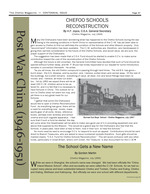 |
Page 27
“...The Chefoo Magazine
CENTENNIAL ISSUE
Page 27
Post War China (1946-1951)
CHEFOO SCHOOLS RECONSTRUCTION
By H.F. Joyce, C.S.A. General Secretary
(Chefoo Magazine, July 1946)
Many Old Chefusians have been wondering what has happened to the Chefoo Schools during the war. Owing to the existing conditions in North China no representative of the C.I.M. has yet been able to gain access to Chefoo to find out definitely the condition of the Schools and other Mission property. Only “second-hand” information has been available. The C.I.M. authorities are, therefore, very handicapped in giving their earnest consideration to the future of the Chefoo Schools, and would value, we are sure, the prayer support of Old Chefusians.
The suggestion has been made that a C.S.A. Fund should be started to enable O.C’s. to make some contribution toward the cost of the reconstruction of the Chefoo Schools.
Although the future is still uncertain, the General Committee have decided that such a Fund should be opened without...”
|
|
| 12 |
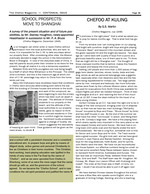 |
Page 28
“...children to be there for the present, though all realize it is only a temporary expedient.
Between thirty and forty youngsters are now being taught by a Staff of which Miss Williamson is the Principal. The oldest child is thirteen, and this is the maximum age at which children of C.I.M. parentage may return to China from the homelands just now.
Many Old Chefusians have doubtless heard that conditions in Chefoo were seriously deteriorating even before the war. With the building of Chinese houses and schools to the south and west of the compound, we were beginning to lose the privacy which has been such an asset in the past. The attitude of Chinese students to our property on the beach, and the attitude of the local authorities to our property-deeds, gave us reason to think that continued residence in Chefoo in comfort might be impossible. Sentiment loudly protested against a change of locality: discretion suggested the desirability
of keeping an open mind. Clear guidance will be given as the need...”
|
|
| 13 |
 |
Page 33
“...The Chefoo Magazine
CENTENNIAL ISSUE
Page 33
Post China Schools & Hostels
CAMERON HIGHLANDS BRINCHANG, MALAYA
By Henry Guiness
(Chefoo Magazine, July 1955)
The words CHEFOO SCHOOLS (a la Mrs. Stooke) in white block capitals on a green board fixed to the ornate gateway, proclaim to the public the presence of a school. The public may not number more than half a dozen in the course of a day, as the place is remote, and the road seldom used. Twice a week the dark olive coloured Austin car winds its way cautiously down the tortuous road that leads in the direction of the Highland shops and returns loaded with vegetables and fruit, stores and provisions for the twenty hungry youngsters that make up the school.
But we must take a look round. On your right is the boys’ vegetable garden where strawberries, beans, tomatoes and lettuces struggle to combat the more virile forms of jungle growth that would defy the most ardent gardener. There in the corner a tin roof marks the boys’ hide-out, which...”
|
|
| 14 |
 |
Page 34
“...procession. We went over to 75 and listened to the first part of the Coronation broadcast on the radio. We heard from when the Queen left Buckingham Palace to when she entered the Abbey and they sang, “I was glad when they said unto me, ‘Let us go into the House of the Lord’”. Miss Dickson heard the rest and told us next morning. Miss Stark sent us books and a model of the procession which we cut out and set up before listening to the programme. The C.I.M. schools are 72 years old now; we feel like a granddaughter of the Chefoo Schools.
Yesterday we ran races and had lots of fun. It has been raining, but it stopped just in time for us to have our sports. . . . We had running, skipping, hopping, bunny jump, egg and spoon, potato, obstacle and grown ups’ races; it was funny to see the ladies running backwards and the men having a wheelbarrow race!... Mr. Faulkner drove us back to school; when we arrived, we found that Mrs. Hatton was back first and had prepared a lovely buffet supper for us...”
|
|
| 15 |
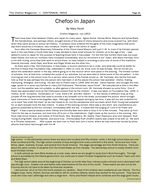 |
Page 35
“...from every continent in the world. Some are from India, Africa, Japan, Australia, Europe, and several from South America. The larger percentage are from North America. There are about the same number of students from the United States as from Canada. The elementary school is mostly children from local Christian homes.
In both schools we have Bible studies as a main class, where we are taught to study God’s Word thoroughly. The high school is accredited by the Alberta government, but continues to teach Christian biographies such as Hudson Taylor and John and Betty Stam.
The high school starts around the beginning of October (a month later than ordinary public schools) and is dismissed halfway through June. Grades nine and twelve have examinations till the end of the month. These exams are sent out by the Province and do not have to be taken by American students.
Last summer, all of us from the home enjoyed our vacation. Most of the children were scattered all over Alberta. The four Hallgren...”
|
|
| 16 |
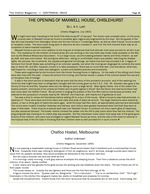 |
Page 36
“...unknown quantity, but when the moving-van disgorged its contents the same day on which Mr. and Mrs. Gaussen moved in to take possession, there was so much that was ‘over-and-above’ what they had hoped for, including a radio and radiogram, a piano and tasteful pictures and ornaments.
These were augmented by the furniture from the former Nursing Home in Highbury. On the walls of the sitting room there were also links with the past: a favourite picture from Kuling, and framed verses in praise of the schools beside the sea and on the green hills of Kiangsi.
It was in the short service of dedication that we were told the story of this wonderful provision, and of the washing machine too that might have been a refrigerator! (bought with the money given by the C.S.A.,-Ed). Mr. Gaussen also gave a testimony of how he and Mrs. Gaussen were led into taking on such a large family. Miss Agnes Clarke, one of the oldest Che-fusians present, reminisced of her pranks at Chefoo and of pacts signed in blood! But...”
|
|
| 17 |
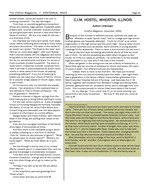 |
Page 37
“...Author Unknown
(Chefoo Magazine, December 1955)
Because of the number of different schools, activities are quite varied. Wheaton is quite “sports crazy”, and so college and high school football games are frequently attended. “Youth for Christ” is an active organization in the high school and the junior high. Various other church and school activities such as parties, band concerts or young peoples’ meetings fill the weekends. There is never a dull moment, but we love it.
Day by day God does exceeding abundantly above all that we could ask or think. He did the exceeding abundant when He gave us this house, for it fits our needs so perfectly. He continues to do the exceedingly abundant in our lives and in the lives of the children.
When we gather in the dining-room we are a family of twenty-five, a family that eats ten pounds of potatoes for dinner and wears 161 pairs of socks a week! Five different schools are represented.
. . . Indeed, there is never a dull moment. We have just finished...”
|
|
| 18 |
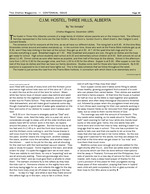 |
Page 39
“...this time Miss Silversides comes around and wakes everybody up. In the summer time, those who work at the Prairie Bible Institute get up at 6.30, and if they help milking in the barn at the school, they get up at 4.30. At 7.15 the quiet time bell rings and for ten minutes everything is quiet. Breakfast begins at 7.30. After breakfast and prayers are over, the girls do dishes and the boys get ready for school. High school students start school at 8.20 and elementary school children at 9.00. Both schools let out at about 11.45. Dinner comes as soon after twelve as possible, and then half of the boys do the dishes. School in the afternoon runs from 1.00 to 3.30 for the younger ones, and from 1.00 to 4.00 for the others. Supper is at 5.30. After supper is over the rest of the boys do dishes and then we have our family devotions. Studies come next for those who have homework. By 9.30 everyone is supposed to be in bed and have lights out. This is the daily schedule that we follow throughout the week...”
|
|
| 19 |
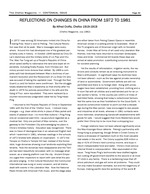 |
Page 43
“...of the ‘Chefoo’ tours. I noticed many changes - e.g. clean white shirts in place of Mao jacket and slacks of peasant blue - no more Mao buttons - Ping Pong only an occasional past time - acupuncture regarded as a medical fad. Only one portrait of Mao remains, over the gateway to the Forbidden City acknowledging his place in China’s timeless history. Education was reorganized. There was no trace of ideological bias in an advanced English text which I examined in 1981, whereas readings in the schools of 1972 bristled with attacks on imperialism. In 1972 the Temple on Chefoo’s Temple Hill had, instead of the former idols, huge dioramas showing cruel landlords exploiting their tenants. Now the dioramas have disappeared and the Temple has been beautifully renovated, with no message whatsoever, as a viewing platform over the city. Ancient Emperors urged their inspectors to report with care what the people were singing. In the Cultural Revolution the Communist International was sung on every occasion...”
|
|
| 20 |
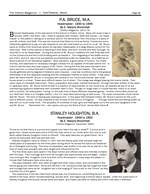 |
Page 46
“...capacity with children, Staff and friends - our Headmaster on the platform calling us to worship God for His deliverance from the piracy of a party of over 90 children and Staff. This was the memory that filled my mind as family, friends and some Chefusians gathered to pay our last respects to one who had meant so much to us all. Mr. Bruce came to Chefoo from Szechuan where he had been Headmaster of a large Mission school for Chinese boys. After a short period of teaching in both Boys’ and Girls’ schools and then furlough, he returned to us as Headmaster. During the period of Mr. Bruce’s headship the new Prep was built on the Compound and the Co-Ed building went up beside it. The integrating of the Staffs and pupils of B.S. and G.S. was most successfully accomplished under his leadership. As a Staff we entered a period of rich fellowship together. Wise discipline, a good sense of humour, his innate humility, and readiness for necessary changes marked him as capable of the task before him. In...”
|
|